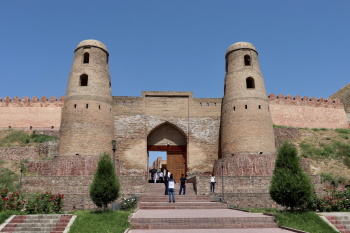Silk Roads Sites in Tajikistan

Silk Roads Sites in Tajikistan is part of the Tentative list of Tajikistan in order to qualify for inclusion in the World Heritage List.
Silk Roads Sites in Tajikistan is a serial nomination with 8 sites, 6 of them also on the TL on their own right. It consists of remains of long-distance routes of integration, exchange and dialogue between the East and the West, from the 2nd century BC until the end of the 16th century. It consists of the ruins of ancient cities representing different period of the Road history, ruins of an ancient monastery, mausoleum or religious schools (representing various different religions from archaic belief to Zoroastrian, Buddhist, Islam) and forts (ruins of Yamutch or still standing like Hissar) protecting the Road.
Map of Silk Roads Sites in Tajikistan
Load mapThe coordinates shown for all tentative sites were produced as a community effort. They are not official and may change on inscription.
Community Reviews
Walter

This serial nomination has 8 different proprieties, six of them having an additional specific entry as their own on the tentative list. I had a chance to visit four of them on my trip to Central Asia in June 2019. Ancient Penjikent and Ancient Town of Khulbuk are reviewed on their specific entries.
Two components are therefore reviewed: Yamchun Castle and Hissar Castle.
These two castles stand on two totally different extremes. Hissar is heavily reconstructed, extremely popular with Tadjik for wedding, and very close to Dushanbe. Yamchun is in the empty, isolated and magnificent Wakham valley, in the extreme south of Tadjikistan, about two days drive (on very very bad roads) from Dushanbe.
The ruins of Yamchun castle lie at 3000 meters, along the long and superb Wakham valley. There is a feeling of the end of the world, in the highest mountains region of the Pamirs, close to where the Himalayas, the Karakoram, the Hindu Kush and the Tian Shan ranges meet. Both sides of the valley are bordered by 6000 meters snow-covered mountains (6723 for Karl Marx Peak). The slopes of the mountains are very arid, and only the bottom of the plain show some green, along the Pandj river on the bottom of the plain. The Panji marks the border with Afghanistan. Travelling there independently is possible, but difficult (rough roads, very few amenities, numerous check-points) so I went on an organized trip of the Pamirs Highway (roughly an itinerary from Osh in Kirghizstan to Dushanbe in Tajikistan).
Yamchun castle lies on a hill above the river and has a triangle plan, 470 m large and 775 m long. The castle is from the 3rd century BC. It is fortified with 9 round tower and some defensive walls, some droping all the way down to the bottom of the valley. The building materials consist of stone with clay mortar. A stream passing nearby has been diverted to bring water close to the castle.
Yamchum castle is a very nice ruins with the most spectacular 360° scenery from its towers. It stands very high on my personal list of best places. It is even more important that I happened to celebrate my 50th birthday on the day of my visit. I might therefore not be very objective, but I believe it deserve a place on the WHS List.
By the way, 2 kilometers uphill from the castle are the Bibi Fatima thermal bath, where local people come to heal different disease, and a great place to relax after long days of bad roads.
Hissar Castle, on the other end, is a very popular place for inhabitants of Dushanbe for a week-end outing are weddings. It lies about 30 minutes drive from the city. On the day of my visit, three full weddings were taking place, with traditional Tadjik clothes and music. This site is interesting to visit because of the atmosphere of wedding. The fort, the gate, and the traditional houses are all reconstructed and really look fake.
The castle functioned from 14th to early 20th century, being destroyed many times, and then reconstructed, including being totally razed by the Red Army in 1924. The only remain of the castle is the Gate Arch, located in the southern facade of the castle, erected in 18th century, but very heavily (and badly) restored. Behind are a few shops in reconstructions of some stone houses. On top of the hill, a new fort is being built, using modern techniques. Needless to say integrity and authenticity criteria cannot be met.
Site Info
- Full Name
- Silk Roads Sites in Tajikistan
- Country
- Tajikistan
- Added
- 2013
- Type
- Cultural
- Categories
- Human activity - Transport and Trade
- Link
- By ID
Site History
2019 Incomplete - not examined
As Silk Roads Zarafshan Corridor
2014 Referred
2014 Advisory Body overruled
From Deferral
2013 Added to Tentative List
Site Links
Visitors
20 Community Members have visited.